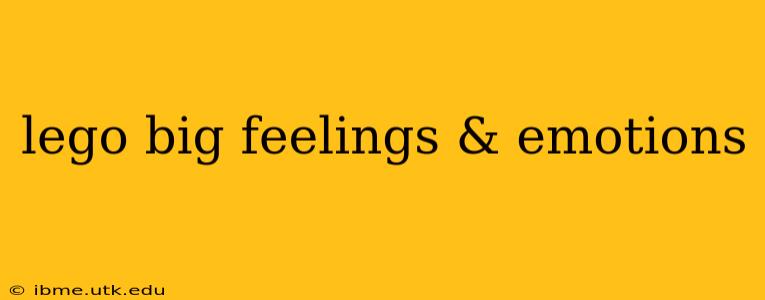LEGOs are more than just plastic bricks; they're powerful tools for learning, creativity, and self-expression. For children, especially, LEGO play offers a unique avenue to explore and understand their "big feelings" – those intense emotions that can sometimes feel overwhelming. This guide explores how LEGOs can be used to build emotional intelligence in children, answering common questions parents and educators often ask.
What are "Big Feelings" in Children?
"Big feelings" encompass a wide range of intense emotions such as anger, sadness, fear, frustration, and joy. These emotions are a normal part of childhood development, but learning to identify, understand, and manage them is crucial for emotional well-being. LEGO play provides a safe and constructive outlet for expressing these feelings. Children can physically build their emotions, creating tangible representations of what they're experiencing, allowing for better processing and understanding.
How Can LEGOs Help Kids Understand Their Emotions?
LEGOs offer a non-verbal way for children to communicate their inner world. They can:
- Build physical representations of their feelings: A towering, jagged structure might represent anger, while a delicate, colorful creation could reflect joy.
- Create scenarios that act out emotional situations: Building a LEGO scene depicting a conflict or a happy family gathering can help children process and explore different emotional contexts.
- Experiment with different emotional expressions: Using LEGO minifigures, children can create facial expressions and poses that reflect various emotions, further enhancing their understanding.
- Develop problem-solving skills: Constructing something challenging can help kids develop resilience and frustration tolerance, crucial skills for emotional regulation.
What are some LEGO activities for exploring big feelings?
Numerous activities can facilitate emotional exploration through LEGO play:
- Emotion Charades: Have children build a LEGO representation of a specific emotion (e.g., sadness, excitement) without speaking, then have others guess.
- Storytelling with LEGOs: Build a scene and create a story that revolves around a particular emotional experience. This can encourage children to articulate their feelings verbally.
- Emotional Landscapes: Children create a LEGO landscape representing how they feel – a sunny, bright landscape for happiness, a stormy, dark landscape for anger.
- "Build Your Feelings" Box: Create a special box with various LEGO bricks and elements. Children can use these materials to spontaneously build whatever represents their current emotional state.
Do LEGOs help children manage their emotions?
Yes, LEGO play actively contributes to emotional management by providing a safe space for expression and exploration. By externalizing their feelings through building, children gain a sense of control and can begin to understand the nuances of their emotions. The process of building itself can be calming and therapeutic, providing a constructive outlet for pent-up energy or frustration.
How can parents and educators use LEGOs to support emotional development?
Parents and educators can actively support emotional development by:
- Providing a safe and supportive environment: Encourage open communication and avoid judgment when children express their feelings.
- Asking open-ended questions: Instead of directly asking "How do you feel?", try "What did you build and what does it mean to you?"
- Modeling healthy emotional expression: Show children how you manage your own emotions in a healthy way.
- Integrating LEGO play into emotional learning activities: Use the suggestions above to incorporate LEGOs into structured lessons or playtime.
Are there any age-appropriate considerations when using LEGOs to teach about emotions?
Absolutely! Younger children may benefit from simpler activities like building basic shapes representing emotions, while older children can participate in more complex storytelling and scenario-building activities. Always choose LEGO sets and activities appropriate for the child's age and developmental stage, ensuring the experience is engaging and not frustrating.
LEGOs provide a unique and invaluable tool for nurturing emotional intelligence in children. By providing a creative and safe space for expression, LEGO play empowers children to understand, manage, and communicate their "big feelings" effectively, paving the way for healthier emotional development.
